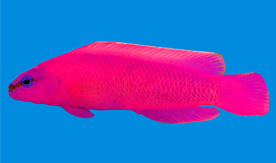
Hamlin discovers certain plastic bags leach nonylphenol in concentrations toxic to fish
Ever buy a fish at a pet store that died within days of being put in an aquarium at home?
The plastic bag in which the fish traveled home may be the culprit, according to research by University of Maine marine scientist Heather Hamlin.
Hamlin and colleagues discovered that certain plastic bags with FDA food-grade approval leach nonylphenol (NP) in concentrations that are highly toxic to fish.
The chemical NP — also found in food packaging, cosmetics and laundry and dish detergents — binds to estrogen receptors. Even at low concentrations, it mimics estrogen, which feminizes and alters fertility in fish, thus threatening their existence.
NP also has been found to alter fish immune function and damage DNA.
Hamlin’s findings, published in the journal Chemosphere, demonstrate that NP may pose a greater health risk to people, the ocean and to aquatic wildlife than can be predicted from examining properties of plastic from one manufacturer, which is the method the FDA currently uses to test for toxicity.
“This study contributes to the growing body of research highlighting concerns with plastic contaminants,” says Hamlin, an assistant professor of aquaculture and marine biology.
“While not all plastic is bad, this study highlights difficulties in differentiating good from bad plastic, and it makes sense to reduce the use of plastics if alternatives, such as glass, are available.”
For the study, for 48 hours, captive-bred orchid dottybacks (Pseudochromis fridmani) were kept in synthetic seawater in Teflon bags, glass bowls or in plastic bags from one of two manufacturers. The FDA labels both types of plastic bags as food-safe polyethylene.
All of the fish in Teflon bags and glass bowls lived for the 48 hours, while 89 percent of the fish in one manufacturer’s plastic bags survived, says Hamlin, a reproductive endocrinologist interested in mechanisms by which environmental factors influence aquatic animal reproduction and development.
In the other manufacturer’s plastic bags (PE2), 60 percent of the fish died within the two days. Those that survived 48 hours in the plastic bags all died within eight days of being released in an aquarium. This, says Hamlin, demonstrates the exposure to NP caused irreversible damage to the fish.
In 48 hours, the NP concentration in the seawater in the PE2 bags was 163 parts per billion (ppb), which is nearly 24 times higher than the U.S. EPA water quality criteria for acute exposure of NP in seawater.
While this study tested for the ability of NP to leach into seawater, Hamlin says it’s possible that food stored in the PE2 plastic bags could absorb increased levels of NP as well and that it’s likely that risks to aquatic animals exposed to increasing quantities of plastic waste could be greater than previously realized.
In 2010, industry demand for NP was estimated to be more than 170,000 metric tons; another study estimated as many as 12.7 million metric tons of plastic waste entered the ocean in 2010.
NPs, says Hamlin, enter aquatic systems though a number of ways, including wastewater discharge.
Studies have indicated NP can last for decades in estuary mudflats. And one survey of 93 organic wastewater contaminants in 139 streams in the United States revealed NP was one of the most commonly occurring contaminants and measured at higher concentrations than other contaminants.
Taking all of this into consideration, Hamlin says greater oversight on the manufacture of plastics and allowable thresholds of contaminant leaching is warranted.
Kathleen Marciano, who earned her degree in marine science with a concentration in aquaculture in 2014 from UMaine; and Craig Downs of Haereticus Environmental Laboratory in Virginia, helped lead the study.
Support for the project came, in part, from a Hatch Grant from the USDA National Institute of Food and Agriculture as well as from the U.S. National Oceanic and Atmospheric Administration Small Business Innovation Research.
Hamlin talks about her research in this video.
Photo courtesy of Sea & Reef Aquaculture
Contact: Beth Staples, 207.581.3777
